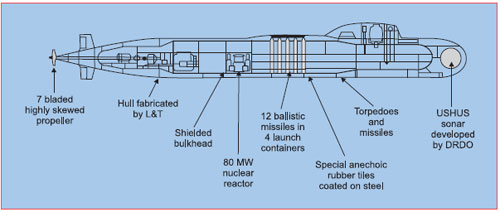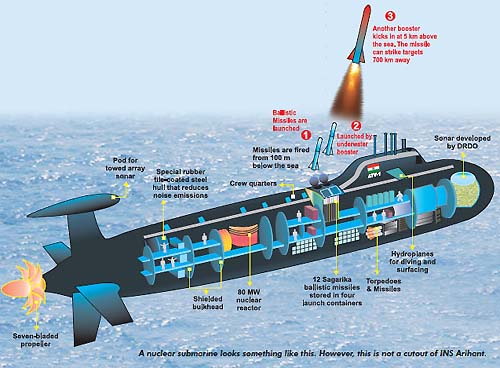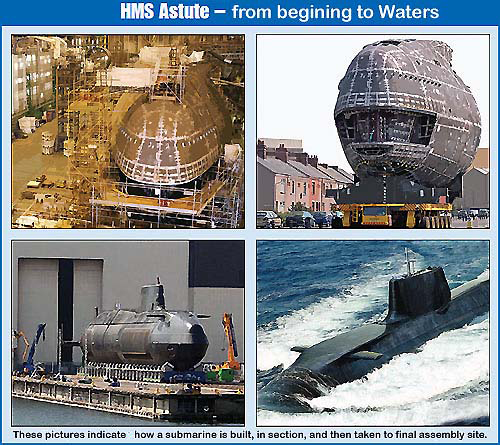|
On 26th July, 2009 in the presence of
Prime Minister Dr Manmohan Singh, his wife, Mrs
Gursharan Kaur, broke the traditional coconut
on the bows of India’s ambitious scientific naval
programme, the 6000 ton nuclear submarine called
by the misnomer an Adavanced Technology Vessel
(ATV) and named it INS Arihant.
The name Arihant is actually a philosophical
adaptation from India’s ancient language Sanskrit
meaning the destroyer of enemies. Mrs Kaur also
gave blessings to all those who would sail on
Arihant, as is the custom, and with that, she
ceremoniously launched the black shark shaped
hull out from under covers of the Matysa drydock
at Vishakhapatnam to come alongside berth B at
the Ship Building Centre (SBC).
Defence Minister A K Antony, Russian Ambassador
Vyacheslav Trubnikov and Defence Research and
Development Organisation (DRDO) head M Natarajan,
Navy Chief Admiral Sureesh Mehta and several senior
naval officers from the past who were associated
with this top secret project from the beginning,
were invited to grace the occasion.
The drydock and berth B were earlier a part of
the sprawling Naval Dockyard built with Soviet
technical assistance and supervision in the 1970s,
when the USSR Navy was looking for a warm water
port in the region for its ships. The Soviet Union’s
large fishing fleet, which reportedly doubled
for intelligence gathering at the height of the
cold war, was also to use this port.
It is to the late Prime Minister Indira Gandhi’s
wisdom however that she actually did not permit
it to become a sort of Soviet base. Instead, they
were informed that they could use Vishakapatnam
for refuge only if any of their ships or vessels
broke down; and that is customary for friendly
nations any way.
The Prime Minister, speaking at the ceremony
said: “The sea is becoming increasingly relevant
in the context of India’s security and we must
readjust our military preparedness to this changing
environment. Our Navy has a huge responsibility
in this regard.”
The launch signified India’s intention to join
the elite club of countries with sea-based nuclear
deterrence. It should take about two years to
conduct standard checks on its various systems,
in shallow and deep waters progressively, and
then activate the nuclear cores, to make the submarine
operational along with its onboard nuclear tipped
ballistic missiles.
Pictures of the submarine were not released and
a group of newsmen invited to witness and cover
the event were only allowed limited access to
footage through official Ministry of Defence cameramen.
India has a vast, 7500-plus km of coastline,
an inadequate number of ships and assets to protect
it, thanks to what has been called the dark decade
of political inaction after 1989.
The work on bridging the gap for the coming years
has picked up, particularly after the 26/11 terror
attacks on India from Pakistani soil, and the
government has cleared several pending proposals
including the acquisition of eight highly advanced
P8-I Maritime Multimission Aircraft (MMAs) from
the US.
India has a declared No-First-Use (NFU) policy
in nuclear weapons. That entails the requirement
for a strong deterrence so that an aggressor can
be punished massively, as the Indian nuclear doctrine
envisages. India already has operational landand-
air launched nuclear missiles and INS Arihant
will extend the deterrence platform to the sea
towards completing the triad for nuclear defence
and attack.
Arihant is to be followed by two more submarines,
which could be slightly larger and perhaps more
powerful in both propulsion and range of missiles.
The Prime Minister was quick to point out though:
”India has no aggressive designs nor do we seek
to threaten any one. We seek an external environment
in our region and beyond, that is conducive to
our peaceful development and protection of our
value system.”
A top official connected with the project told
India Strategic that the Indian
Government was according highest priority to coastal
defence after the 26/11 attacks and subsequent
projects were being appropriately advanced, thanks
to the experience gained in building the first
nuclear submarine. “It was relevant in the past,
and it is relevant now, that India should itself
take care of its vast coastal interests and secure
its maritime interests due to the troubled region
around the country.”
 The
hull of the submarine was built by the private
sector Larsen & Toubro, a technology-driven USD
8.5 billion engineering company, and it is already
in the process of building the subsequent hulls. The
hull of the submarine was built by the private
sector Larsen & Toubro, a technology-driven USD
8.5 billion engineering company, and it is already
in the process of building the subsequent hulls.
Notably, Chief of Staff of the Indian Navy, Admiral
Sureesh Mehta, has disclosed that the Navy has
undertaken projects worth around $ 2.5 billion
every year for some time to make up for the delay
in modernization and acquire the latest in capabilities.
Both the public and private sectors are being
invited to participate on equal basis in this
programme, reserved mainly for government-run
companies in the past. (See Box).
The Indian Navy’s increasing role and responsibility
were signified by the Prime Minister when he mentioned
the words “our region and beyond.” Actually, the
Indian Navy’s Maritime Strategy and Doctrine are
based on India’s area of interests, as ranging
from the Gulf of Aden to the Straits of Malacca
and the sea lanes of communications in the Indian
Ocean.
 This
itself underscores the need for a larger navy,
and a nuclear fleet which can stay hidden for
upto six months. This
itself underscores the need for a larger navy,
and a nuclear fleet which can stay hidden for
upto six months.
Notably, the idea for India having nuclear submarines
was first mooted by India’s leading nuclear scientist
Raja Ramanna and Vice Admiral Mihir Roy, who shared
a room while studying in London long back. Dr
Ramanna oversaw India’s first nuclear test on
18 May 1974.
When Mrs Gandhi approved the idea of nuclear
submarines in the laste 1970s, he involved Mihir
Roy, then a young naval officer.
Roy, now 84, says that the project was so secret
that he never shared his involvement even with
his family till the government recently acknowledged
its existence.
The ATV Project and RUSSIA
The classified ATV project, or Arihant, has
been pursued and administered by the DRDO, Bhabha
Atomic Research Centre (BARC), and the Indian
Navy with coordination and control directly from
the Prime Minister’s Office (PMO) since1980, when
the then Prime Minister Indira Gandhi gave it
the go-ahead.
After 1989, it progressed haltingly. Yet, it
has been a unique partnership between the Indian
industry and DRDO, nuclear scientists at BARC,
and the Navy. The Soviet Union, and later Russia,
have given the project important guidance and
building support, training Indian crew onsite
as well as on board a nuclear submarine – the
Charlie class Chakra leased by India from 1988
to 1991 – sharing important materials and their
welding techniques. Russia also supplied the special
steel needed for submarines and ships, and possibly
parts of the nuclear reactor.
Russian advice has also been taken to give it
some stealth capability, and rubber tiles, made
in India, have been installed for noise suppression.
The Russian presence of Ambassador Vyacheslav
Trubnikov and a large number of Russian specialists
was significant at the ceremony, clearly indicating
their role.
Stage of Completion
INS Arihant is reported to be slightly larger
than the Charlie class which India had leased
from 1988 to 1991, and is in a fairly advanced
state of completion, perhaps up to 75 per cent.
Appropriate reactor components, built by BARC
and L&T, were ferried to Vishakhapatnam from different
parts of the country. Nuclear vessels are expensive
as they need cutting-edge technology, and are
also time consuming to build. It is not easy to
ferry particularly oversized components over long
distances, but that has to be done. (See illustration
of HMS Astute).
Arihant is 6000 tonnes and 104 metres long.
Hulls for two more vessels, reportedly longer
and with more displacement, are ready.
Indications are that a total of seven nuclear
submarines will be operational within the coming
decade. Two of these should be launched by 2014,
a year or so after INS Arihant is commissioned
for operations in the Indian Ocean.
The newer submarines are likely to be larger
to accommodate progressively increasing sensor
and weapons package. Right now, the onboard missiles
are reported to be capable of reaching an effective
range of 750 km. Eventually, this range could
be five to six times as much, say 3500 to 4000
km.
Design changes for the next two boats are reported
to have been completed.
Cost estimates are not available but once the
companies involved are given an indication for
a larger number, up to seven, there would be stabilization.
Instead of expenditure on design and basic research
and fabrication, the emphasis would be on sensors
and missiles.
INS Arihant and other submarines will have connectivity
with the aerial assets of the Indian Navy as well
as the Indian Air Force (IAF) including maritime
patrol aircraft.
All these Indian submarines will be in the nuclear-propelled,
nuclear ballistic missile attack category, or
SSBN.
In the next one year while the Arihant is berthed
at Berth B, technicians, constructors and the
skeleton crew will be required to attend to finishing
internal fittings, and complete what is known
as harbour acceptance trials (HATS).
The steering gear operations and the critical
shaft alignment, which provides the best speed,
will be carried out.
The myriad of control systems, periscopes, propulsion
machinery and generators will have to be operated
in harbour with the power supply and steam from
external boilers set up at the Ship Building Centre(SBC).
Only when all systems have been proved to the
laid-down standards, will the computer controlled
80 MW miniaturized reactor will be made critical
in stages, accelerating to full potential and
required speed and depths.
There are also reports that the reactor, ensconced
inside the boat in a stainless steel casing, has
been supplied by Russia. Details of what exactly
has been given by Russia though and what has been
fabricated in India, are not available.

But this will be the first time that the internal
heat exchangers manufactured by the state-run
heavy engineering company, Bharat Heavy Engineering
Ltd (BHEL), will provide the full pressurised
steam to run the turbines and generators to prepare
for contractors’ sea trials (CST). The seven bladed
propeller will be turned by the reduction gear
and then by the turbines.
BHEL is India’s largest energyrelated engineering
enterprise.
The Voyage
It will be a historic day when the Captain designate
of Arihant takes her on a maiden voyage and makes
the clarion message, “Proud To Report Underway
Successfully on Nuclear Power”, just like the
USS Nautilius, USA’s first nuclear submarine reported.
The submarine will then make shallow dives, complete
the deep diving trials and operate the USHUS sonar
to prepare for the weapon trials of the torpedoes
and missiles with dummy warheads. The boat will
then be commissioned in to the Indian Navy.
Reports from Moscow indicate that Nerpa, the
Akula class nuclear submarine which India is leasing
from Russia, will be delivered to the Indian Navy
by 2009 or around.
That will help finetune the Indian naval crew's
capabilities in operating nuclear submarines.
Many of the Arihant’s crew have already been
trained in Russia.
There is also a nuclear submarine training facility
in India at Kalpakkam, near Tamil Nadu’s capital
city of Chennai, to train the Indian crews in
batches.
Nerpa will help give additional experience to
Indian officers and men in hastening Arihant’s
commissioning.
The Indian Navy is determined to make India’s
deterrent from the sea effective soon.
DRDO has indicated that the submarine will carry
the K-15, 750 km nuclear tipped missiles.
Nuclear Submarine building
facilities
A large planning and design office called Akanksha
(Hope) in New Delhi, has directed the ATV programme
under the current Director General, retired Vice
Admiral D S P Verma.
Facilities at Vishakapatnam have been built by
the DRDO, industry and the Indian Navy with BARC’s
collaboration with funds and monitoring from the
PMO.
Two Admirals with technical expertise have headed
the two large supporting complexes. One is the
sprawling Defence Material Department (DMD) at
Hyderabad, which collaborates with DRDO labs and
BHEL for the heat exchanger turbine propulsion
system, and MIDHANI for special steel requirements
and other contractors. The large Submarine Building
Centre (SBC), tucked behind high walls and barbed
wires in the heart of Vishakapatnam, is where
the hull was put together in sections provided
from engineering and refinery reactor maker L&T.
This company is investing heavily in ship building,
and already has facilities at Hazira in Gujarat
and Mazagon Docks in Mumbai (Bombay).
Walchandnagar Industries provided the gear box
and shafting as it does to Indian Navy’s Leanders.
Bharat Electronics Ltd (BEL), another state-run
company, is fitting out the USHUS sonar, radars
and the Combat Management System along with Tata
Power Ltd which has a tieup with BAE Systems for
the control pedestal.
KSB pumps and Jindal pipes have also played
a significant role. The submarine is coated with
rubber anechoic tiles supplied by a rubber vulcanising
firm in Mysore to provide stealth qualities.
The Russian assistance has been substantial by
way of the design, critical parts, the reactor
enriched uranium pellets and inputs.
BARC, which steered the critical nuclear reactor
installation programme in 1975, also manufactures
and stores India’s fission and fusion atomic bombs.
It has provided training to Navy’s technical officers
in submarine nuclear technology.
The ATV project has also set up a small submarine
reactor training complex at Indira Gandhi Centre
for Atomic Research (IGCAR), Kalpakkam, near Chennai
with facilities to test the 80 MW–plus pressure
water reactors before insertion into submarine
hulls. The reactor is normally sealed into a 600-ton
titanium shell of about 10 metres in diameter.
According to a former Indian Navy nuclear boat
Captain with command of INS Chakra, “the nuclear
submarine operates like any other under water
boat, except that it can stay under water for
months and it is imperative that the key members
learn to operate the computer controlled nuclear
power plant… Each crew member has to be aware
of all the possible emergencies including emergency
shut down that can take place in the ensconced
nuclear reactor.”
The nuclear safety drill is very important and
so are the facilities of nuclear safety at the
Vishakapatnam and other berths the submarine may
visit.
The Indian Navy has a full team for nuclear safety
under a submarine Vice Admiral at Naval Head Quarters
as its Director General. Expanded berthing facilities
are likely to be created in the long run at some
ports for nuclear submarines and large vessels
like aircraft carriers.
Vishakhapatnam's history
and future
Soviet Union’s famous Admiral Sergie Gorshkov
had visited Vishakapatnam in 1977 and suggested
to the Indian Navy that it would be better served
if it sets up a dedicated naval base at Bimlipatam,
North of Vishakapatnam, visualising the future
and the constraints of the Vizag harbour’s narrow
entrance.
Former Vice Admiral Daya Shankar supported this
view. But India could not afford the high capital
costs.
However, the Ministry of Shipping has now agreed
to transfer part of its Hindustan Shipyard Ltd
(HSL) to the Defence Ministry for pursuing submarine
construction and refits. The Kilo class INS Sindhukrti
has been laid up at HSL for the Club missile and
USHUS sonar upgrade.
To support this huge ATV project, universities
and commercial firms have been employed on an
ad hoc basis, including the well-equipped Naval
Design Directorate in New Delhi.
It is now common knowledge that since 1971,
Indian scientists were attempting to produce a
compact nuclear power plant (reactor) design suitable
for use at sea. Captain Kotta Subba Rao, under
the guidance of Dr Raja Ramanna, Dr Srinivasan
and Dr Iyengar, the stalwarts who steered India’s
nuclear programme, had been trying since 1975
to design and build a miniaturised submarine reactor
at BARC.
Of the three reactor designs evaluated, the first
was rejected in late 1976, the second in 1979
and the third in 1981. Captain Subba Rao had also
tabled a design but he left the Navy prematurely
and was apprehended at Mumbai airport while carrying
his reactor design to the USA and was imprisoned
for 20 months. He was finally found innocent as
it was proved that he had presented this very
theoretical design cleared by NHQ, as his thesis
project for his Phd Doctorate.
Today, India has the ability to design miniature
reactors.
India’s nuclear triad, once operational by 2012
or 2013, will offer the best bang for the big
bucks that the Indian Naval planners are spending
on the ATV, which must succeed and the nation
must be told how important it is. The offshoots
of the project when made public will help the
Indian public and private sector Industry to blossom.
(The author is a former
Director Naval Intelligence and Director Naval
Operations, and has worked on the miniature nuclear
training reactor at Greenwich called Jason and
witnessed robotic nuclear fuel change operations
at an Indian facility).
|